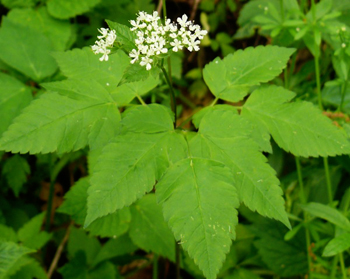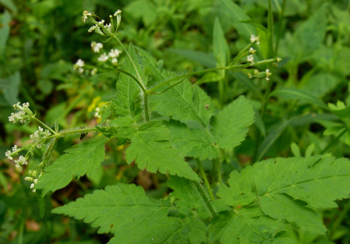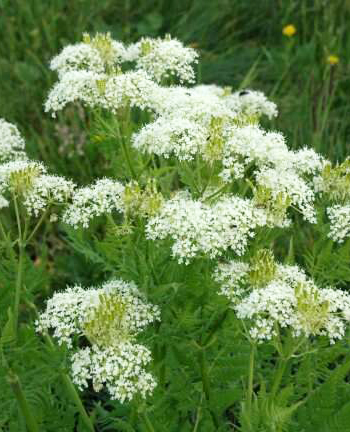Contents:
Common Names | Parts Usually Used | Plant(s) & Culture | Where Found | Medicinal Properties
Legends, Myths and Stories | Uses | Warning | Bibliography
Scientific Names

- Osmorhiza longistylis L.
- Osmorhiza claytonii
- Myrrhis Odorata L.
- Umbelliferae
- Umbel family
Common Names
Osmorhiza longistylis:
- Anise root
- Sweet anise
- Sweet cicely
- Sweet chervil
Osmorhiza claytonii:
- Native sweet cicely
- Sweet cicely
Myrrhis Odorata:
- European Sweet Cicely
- Sweet chervil
- Sweet cicely
- Sweet fern
Parts Usually Used
All varieties: Root
Back to Top
Description of Plant(s) and Culture

Osmorhiza longistylis:
Sweet cicely is a perennial plant; the thick, bundled roots produce branched stems from 1 1/2 to 3 feet tall. The alternate, ternate-pinnate leaves grow on sheathing petioles and have ovate to oblong-ovate leaf segments. The inconspicuous white flowers grow in loose compound umbels during May and June. The whole plant has an anise-like odor, very sweet, aromatic, fleshy; stouter and nearly smooth compared to O. claytonii.
Osmorhiza claytonii:
This sweet cicely is a soft-hairy perennial abut 1-3 feet tall. The root is rank-tasting and the leaves fernlike, thrice-compound. The flowers are tiny, white and appear May to June.
Myrrhis Odorata:
This sweet cicely is a bushy perennial; has a thick root and bright green, fernlike leaves, borne on branching stems that resemble parsley. Very small, clustered white flowers bloom in May and June and are followed by dark brown to black seeds. All parts of the plant are edible and taste and smell like anise. The flowers retain their anise perfume after drying.
Back to Top
Where Found

Osmorhiza longistylis:
Grows in the woodlands of Canada, Alaska, and southward to Colorado and Georgia.
Osmorhiza claytonii:
Found in moist woods; Nova Scotia to North Carolina mountains; Alabama, Arkansas to Canada.
Myrrhis Odorata:
Grows throughout Europe and the British Isles, and while not common, it is naturalized in the United States. Grown everywhere in the United States except along the Gulf Coast and in southern Florida, where the winters are too warm.
Back to Top
Medicinal Properties
Osmorhiza longistylis: Carminative, expectorant, stomachic
Osmorhiza claytonii:
Carminative, expectorant, stomachic
Myrrhis Odorata: Aromatic, carminative, expectorant, stomachic
Back to Top
Legends, Myths and Stories
Some references claim sweet cicely belongs to the parsley or carrot family, but Webster’s Dictionary states clearly that it belongs to the umbel family.
There is an herb known to the Blackfeet Indians as Paoh-coi-au-saukas; it is called sweet cicely (Washingtonia divaricata). “Smell mouth”. Roots placed in mares’ mouth, and made to chew them. Drinks more water, and put them in good condition for foaling. The green seeds taste like licorice candy.
Throughout the writings on sweet cicely are references to other plants it resembles: chervil, ferns, hemlock, and anise. Sweet cicely is the herb that just doesn’t seem to have a personality of its own.
The plant is strongly scented. Curiously, the plant has no recorded history of use for its scent, its botanical name, Myrrhis odorata, is derived from the Greek for perfume. One herbalist reports that in sections of England it is called the Roman plant and suggests that this name may be a clue to its original introduction.
Sweet cicely (Washingtonia divaricata) was known to the Blackfeet as “Paoh-coi-au-saukas,” or “smell mouth.” The roots were placed in a mares’ mouth, and made to chew them. The mares drinks more water, and puts them in good condition for foaling.
Back to Top
Uses
Osmorhiza longistylis:
The root is used much like anise. Taken for flatulence, mucous congestion, indigestion, and lack of appetite, alleviates cramps and nausea, parturition (childbirth) and relieves flatulence and, especially in infants, colic. Is useful as an expectorant for coughs. Sweet cicely water promotes milk production in nursing mothers, and a soothing eyewash. Said to promote the onset of menstruation when taken as an infusion. Sweet cicely oil helps relieve cramping, and spasms and is good as a stomach tonic. For insomnia, that a few seeds in a glass of hot milk before bedtime. Can be made into a salve to use for scabies or lice. Native Americans poulticed the root on boils, wounds. Because of its sweetness, sweet cicely is a good additive to improve the flavor of other medicines. The root was eaten raw or soaked in brandy.
Osmorhiza claytonii:
Native Americans chewed the root or gargled root tea for sore throats; poulticed root on boils, cuts, sores, wounds; tea as a was for sore red eyes, and relieve coughs.
Myrrhis Odorata:
Anise like; fresh root eaten, it is said to be a gentle stimulant for debilitated stomachs and good for coughs and flatulence. The infusion of the root is said to be good as a tonic for young girls. The juice applied externally, helps to heal ulcers. Helps increase appetite and aids onset of menses.
Back to Top
Warning
All three species listed in this report should be carefully identified before use.
Do not confuse with Poison Hemlock (Conium maculatum L.)
Back to Top
Bibliography
![]() Eastern/Central Medicinal Plants
Eastern/Central Medicinal Plants, by Steven Foster and James A. Duke., Houghton Mifflin Company, 215 Park Avenue South, New York, NY 10000
![]() The Herb Book
The Herb Book, by John Lust, Bantam Books, 666 Fifth Avenue, New York, NY. copyright 1974.
Herbal Gardening, compiled by The Robison York State Herb Garden, Cornell Plantations, Matthaei Botanical Gardens of the University of Michigan, University of California Botanical Garden, Berkeley., Pantheon Books, Knopf Publishing Group, New York, 1994, first edition
 How Indians Use Wild Plants for Food, Medicine & Crafts
How Indians Use Wild Plants for Food, Medicine & Crafts, by Frances Densmore, Dover Publications, Inc., 180 Varick Street, New York, NY 10014, first printed by the United States Government Printing Office, Washington, in 1928, this Dover edition 1974
![]() Indian Uses of Native Plants
Indian Uses of Native Plants, by Edith Van Allen Murphey, Meyerbooks, publisher, PO Box 427, Glenwood, Illinois 60425, copyright 1958, print 1990
![]() Webster’s New World Dictionary
Webster’s New World Dictionary, Third College Edition, Victoria Neufeldt, Editor in Chief, New World Dictionaries: A Division of Simon & Schuster, Inc., 15 Columbus Circle, New York, NY 10023
 The Rodale Herb Book: How to Use, Grow, and Buy Nature’s Miracle Plants (An Organic gardening and farming book)
The Rodale Herb Book: How to Use, Grow, and Buy Nature’s Miracle Plants (An Organic gardening and farming book), edited by William H. Hylton, Rodale Press, Inc. Emmaus, PA, 18049., 1974
